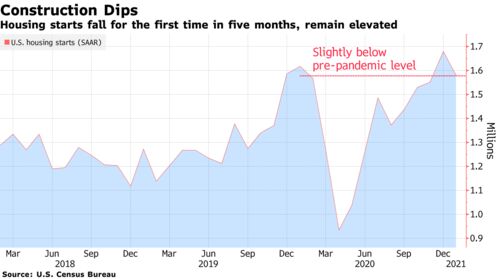U.S. home-construction starts fell in January for the first time in five months, signaling that rising residential real estate prices may be constraining buyer demand.
Residential starts dropped by 6% from the prior month to a 1.58 million annualized rate, according to government data released Thursday. The median in a Bloomberg survey of economists had called for an decline to a 1.66 million annualized rate.

What’s moving marketsStart your day with the 5 Things newsletter.EmailBloomberg may send me offers and promotions.Sign UpBy submitting my information, I agree to the Privacy Policy and Terms of Service.
The figures suggest that record-high prices may be weighing on affordablity and subduing further growth in the housing market. Still, housing starts remain above pre-pandemic levels thanks to the Federal Reserve’s ultra-easy monetary policy pushing mortgage rates to record lows and driving demand upward.
Single-family housing starts, which were at the highest since 2006 by the end of last year, decreased by 12.2% to a 1.16 million pace. Multifamily starts, which tend to be volatile, surged 17.1% to a 418,000 pace, the fastest since July.
A measure of confidence among U.S. homebuilders improved slightly in February amid strong demand conditions, even as rising construction costs related to lumber costs threaten to slow demand, a report from the National Association of Home Builders showed Wednesday.
While housing has been strong, the labor market has struggled to recover. A separate government report showed Thursday that initial filings for state unemployment benefits rose to 861,000, worse than estimated.
January data on existing home sales, which increased unexpectedly in December, will be released by the National Association of Realtors Friday.
Digging Deeper
- Applications to build, a proxy for future construction, surged 10.4% to an 1.88 million pace, the highest since May 2006
- The total number of residential projects authorized but not yet started climbed to 204,000 and remains well above pre-pandemic levels, suggesting builder backlog remains robust
- Housing starts declined in the Midwest, South and West, and rose slightly in the Northeast.



